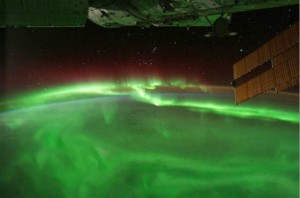According to Spaceweather.com there is 30% chance of a ‘severe’ Aurora Australis / Aurora Borealis occurring in the next 48 hours. For Southern Australian observers, the most likely time that we will see one is Monday night (26 September 2011) according to the Australian IPS Radio and Space Services website.

To have the best chance of seeing an aurora (in Australia), you will need to live either in Tasmania or the Southern part of mainland Australia. Aurora experts recommend looking around local midnight. That said, I saw an aurora from Canberra during the last solar maximum at around 8 pm AEST. You will need to be in a location with very little light pollution to have a chance of seeing the aurora as they are not bright. If one occurs, you will see faint reddish or greenish clouds moving slowly above the Southern horizon. A useful fact sheet about aurora can be downloaded here from the Space Environment Center website. You might also want to look at this amazing video of the International Space Station passing above an aurora.
I live in the Huon Valley in Southern Tasmania, Australia. As a software developer I spend hours programming late in to the night.
I can confirm that Monday last week (26/9) I went outside at 3:00 AM for some fresh air and looking south I noticed a light green glow. At first I was wondering what it was because I had never seen the moon that far south, nor emanating green light.
As it became brighter I realised it was the Aurora Australis. I could see the N-S streaks running through it. It was only a low glow stretching up from the horizon to about 15 degrees above the horizon. It was quite spectacular.
It is only now that I have stumbled on this website after doing a Google search to see how many others saw it – yes the prediction of an Aurora Australis was correct.
I hope to see this again, it was awesome.
Shane,
Thanks for posting a comment about the aurora. It is good to now that someone saw it.
Regards,
Paul Floyd.
Recently, I read that it is possible to view aurora in Melbourne. Appreciate if you could highlight locations where it is most hopeful for sightings in late July.
Stephanie,
Any location away from city lights with a clear horizon to the South will give you a good view of an aurora. I do know that aurora are often seen from the Mornington Peninsula.
Keep in mind that aurora cannot be predicted months in advance. For an aurora to occur, a coronal mass ejection has to occur, travel towards and then impact the Earth’s magnetosphere. It has to be large enough to trigger a very bright aurora – which is then visible from Melbourne latitudes.
The best thing you can do is keep an eye on a website like http://www.spaceweather.com, my site and more importantly my Twitter account. Then be prepared to jump in the car and drive away from city lights for the chance of seeing one, when you hear that a bright Southern hemisphere aurora is occurring.
Regards,
Paul Floyd.